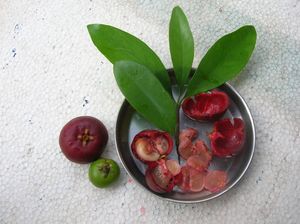Note: This is a project under development. The articles on this wiki are just being initiated and broadly incomplete. You can Help creating new pages.
Difference between revisions of "Garcinia indica - Vrikshamia"
(→Properties) |
(-stub) |
||
| Line 1: | Line 1: | ||
| − | |||
| − | |||
[[File:Garcinia indica - fruits, seeds, pulp and rinds.jpg|thumb|right|KOKUM(punarpuli)]] | [[File:Garcinia indica - fruits, seeds, pulp and rinds.jpg|thumb|right|KOKUM(punarpuli)]] | ||
Revision as of 17:57, 11 May 2018
Garcinia indica a plant in the mangosteen family, mostly in Asia and Africa. Garcinia indica is indigenous to the Western Ghats region of India located along the western coast of the country.
Contents
- 1 Uses
- 2 Parts Used
- 3 Chemical Composition
- 4 Common names
- 5 Properties
- 6 Habit
- 7 Identification
- 8 List of Ayurvedic medicine in which the herb is used
- 9 Where to get the saplings
- 10 Mode of Propagation
- 11 How to plant/cultivate
- 12 Commonly seen growing in areas
- 13 Photo Gallery
- 14 References
- 15 External Links
Uses
Indigestion, Cuts, Snakebites, Diabetes, Cancers, skin problems, Pimples, Diarrhea, Sore throats
Parts Used
Chemical Composition
Cyanidin-3-glucoside and cyanidin-3-sambubioside[1]
Common names
| Language | Common name |
|---|---|
| Kannada | murgina, punarpuli |
| Hindi | Kokum |
| Malayalam | kaattampi |
| Tamil | murgal, murgal-mara |
| Telugu | |
| Marathi | NA |
| Gujarathi | NA |
| Punjabi | NA |
| Kashmiri | NA |
| Sanskrit | Vrikshamia, Amlabija |
| English | Kokam, Goa butter tree |
Properties
Reference: Dravya - Substance, Rasa - Taste, Guna - Qualities, Veerya - Potency, Vipaka - Post-digesion effect, Karma - Pharmacological activity, Prabhava - Therepeutics.
Dravya
Rasa
Amla (sour), Madhura (sweet)
Guna
Ruksha (Dry), Guru (heavy)
Veerya
Ushna (Hot)
Vipaka
Madhura (sweet)
Karma
Kapha, Vata
Prabhava
Habit
Identification
Leaf
| Kind | Shape | Feature |
|---|---|---|
| Simple | The leaves are divided into 3-6 toothed leaflets, with smaller leaflets in between |
Flower
| Type | Size | Color and composition | Stamen | More information |
|---|---|---|---|---|
| Unisexual | 2-4cm long | Yellow | 5-20 | Flowers Season is June - August |
Fruit
| Type | Size | Mass | Appearance | Seeds | More information |
|---|---|---|---|---|---|
| 7–10 mm (0.28–0.4 in.) long pome | clearly grooved lengthwise, Lowest hooked hairs aligned towards crown | With hooked hairs | {{{6}}} |
Other features
List of Ayurvedic medicine in which the herb is used
- Vishatinduka Taila as root juice extract
Where to get the saplings
Mode of Propagation
How to plant/cultivate
Garcinia indica requires a warm and humid tropical climate.[3]
Commonly seen growing in areas
forest lands, riversides, wastelands.
Photo Gallery
- Garcinia indica Kokum of Karnataka Maharashtra Gujarat India.jpg
References
External Links
- Pages with broken file links
- Ayurvedic Herbs known to be helpful to treat Indigestion
- Ayurvedic Herbs known to be helpful to treat Cuts
- Ayurvedic Herbs known to be helpful to treat Snakebites
- Ayurvedic Herbs known to be helpful to treat Diabetes
- Ayurvedic Herbs known to be helpful to treat Cancers
- Ayurvedic Herbs known to be helpful to treat skin problems
- Ayurvedic Herbs known to be helpful to treat Pimples
- Ayurvedic Herbs known to be helpful to treat Diarrhea
- Ayurvedic Herbs known to be helpful to treat Sore throats
- Herbs with Leaves used in medicine
- Herbs with common name in Kannada
- Herbs with common name in Hindi
- Herbs with common name in Malayalam
- Herbs with common name in Tamil
- Herbs with common name in Sanskrit
- Herbs with common name in English
- Habit - Tree
- Index of Plants which can be propagated by Seeds
- Index of Plants which can be propagated by Cuttings
- Herbs that are commonly seen in the region of forest lands
- Herbs that are commonly seen in the region of riversides
- Herbs that are commonly seen in the region of wastelands
- Herbs




